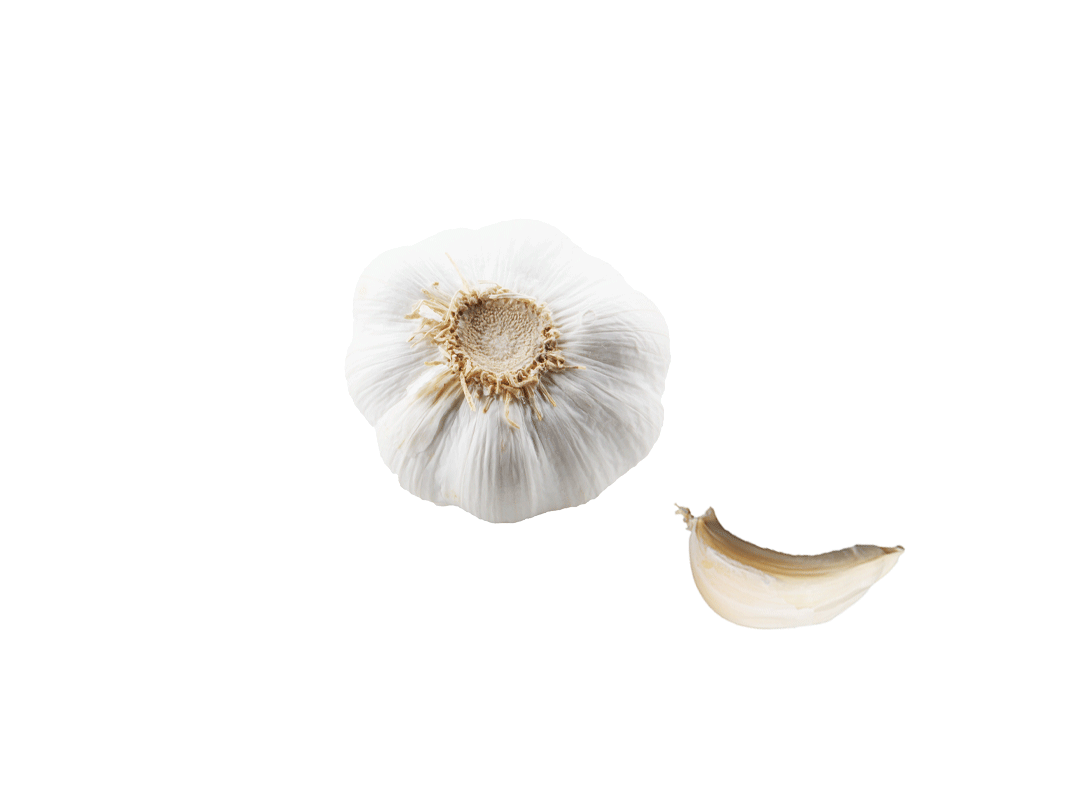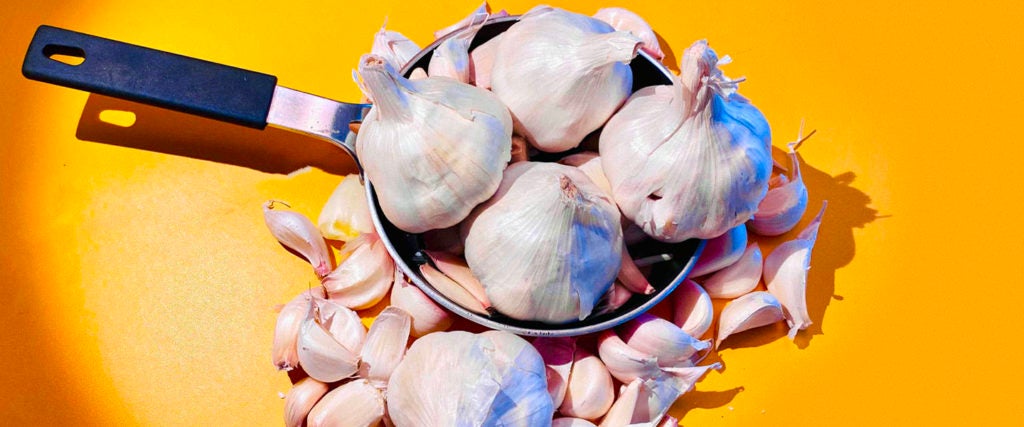Ah, garlic — nature’s cockblock.
But that doesn’t stop anyone from being obsessed with it. Ask Twitter about the stuff, and the response will be overwhelming and unanimously in favor. It’s not hard to see why the sharp, pungent herb is ubiquitous in home cooking. Aside from its beneficial Dracula-repellant characteristics, it’s cheap and available in basically every supermarket. And it plays an important role in a staggeringly vast array of cuisines. Whether you’re cooking spaghetti Bolognese, pork fried rice or chicken vindaloo, you’ll have to reach for the garlic.
please give me your opinion on garlic
— rax ‘jewish space lazar wolf’ king (@RaxKingIsDead) January 27, 2021
Just as common as the adulation for garlic is the contention that recipes never call for cooks to use enough of it. “Translate all recipes’ calls for ‘X number of cloves’ to ‘X number of heads,’ and it will always be better,” advises fellow MEL contributor Calvin Kasulke.
“Love it. There is nothing like too much. Elevates a simple dish to something meaningful. How much garlic do I want? Yes,” poet Meher Manda rhapsodizes.
“More. Always more,” writer Kristy Puchko says simply.
I hate to contradict my excellent friends and colleagues, but: I disagree.
Don’t get me wrong. Garlic is delicious and all my favorite dishes and cuisines would be lost without her. In fact, I take a heavy-ish hand with garlic when I cook; I’m a longtime friend of everything from spicy kimchi to the humble garlic knot. And the history of anti-garlic sentiment in the U.S. is also a history of quack medicine and bigotry against the immigrants who cooked with it most frequently, two embarrassments with which I prefer not to align myself. My point, then, isn’t that garlic should abdicate its throne as the world’s most beloved seasoning. Its throne is earned, its position safe. My point is that there is such a thing as too much garlic and you people need to relax (emphasis, of course, mine).
And I’m not the only one who feels this way about the stinking rose. “I tend to agree,” says Lauren L. Walker, co-writer of the recipe newsletter The Paper Plate. “I see that kind of thing on newbie cooking forums on Reddit. It has the feeling of a more subtle version of the ‘everything goes better with bacon’ idea that dominated internet cooking discussion in the 2010s.”

Ex-line cook Hannah Rego takes a stronger position still. “Working in a kitchen, I learned the value of restraint, of putting just one herb in a good trout and letting ingredients taste like themselves,” they say. “What I’m saying to you is this: Put the garlic down, and depending on what you’re making, exchange that five extra cloves for fresh ginger, fish sauce or freshly-ground toasted coriander.”
Admittedly, I was like you once, you users of two or three heads of garlic per dish. The first dish I ever cooked well was “Chicken With 40 Cloves of Garlic,” a meal that does pretty much exactly what it says — and it came out so well because, frankly, it’s hard to fuck it up. The three heads of garlic do all the heavy lifting, and both prep and cooking are otherwise minimal. In fact, chicken with 40 cloves of garlic speaks to one thing many cooks love most about the herb: It’s not fussy. It requires no time-consuming rehydration like dried chilis, no digging in the pot after hours of cooking like a bay leaf that needs to be removed. You need only a knife and the willingness to stink for a day or two.
Walker recommended that I watch Les Blank’s 1980 documentary Garlic Is as Good as Ten Mothers, an utterly charming look at garlic’s role in a number of cuisines. It features garlic-centric interviews with Black barbecue pitmasters, Italian mothers prepping their Sunday dinners, Chinese chefs throwing handfuls of the stuff into sizzling woks. The film presents a consensus: Garlic is great. (Which it is!) It’s healthy for the people who eat it, seeming to reduce blood pressure and cholesterol. It’s cheap and accessible enough that the very poorest survivors of the Spanish Civil War were able to survive on garlic and little else for years. (One survivor demonstrates a common post-war sandwich of garlic and tomatoes. “Very little bread,” he insists, the implication being that even the staff of life was too luxurious for the circumstances.)
One viewpoint that the film presents is obvious but often unrecognized: For white Americans, the love of garlic is pretty new. “It did seem that there was a sudden explosion, an exponential explosion of interest in garlic,” acknowledges Lloyd J. Harris, author of 1974’s appropriately titled The Book of Garlic. “And it had to do with the sort of coming together of interest in herbalism and folk medicine, interest in spices and interest in European and Mediterranean cooking.”
A newfound interest in garlic meant a sudden preponderance of recipes that called for it, recipes that naturally persist to this day. Here, both Walker and I are once again dubious, inasmuch as people’s attitude toward these recipes is how can anyone use only two measly cloves of garlic? “I don’t know how garlic fits into recipe-making in general,” Walker says. “Garlic changes so much depending on where you are in the world, or even if you’re buying conventional American garlic or ‘elephant garlic’ at Safeway.”
In other words, what garlic-loving home cooks see as a recipe’s miserliness with the garlic may just be a failure of standardization. Garlic is, you know, a plant. A living thing. How can a recipe dictate that my two cloves of garlic here are the same as your two cloves of garlic in your corner of the world? How can Fannie Farmer possibly know? In a professional kitchen, where cooks handle huge quantities of food in a hurry every day, the unit wouldn’t be something like two cloves of garlic — it would be a loose pinch. Garlic is measured less in units than in terms of a cook’s personal preference.
Still, there’s no denying that garlic has star power. “It’s not like being drunk — being drunk or stoned is a different kind of euphoria,” says one cook of an experience he terms “garlic euphoria.” He’s speaking to Blank’s camera at a garlic festival hosted by renowned California restaurateur Alice Waters, so one assumes he really knows his stuff, garlic-wise. “Garlic euphoria is kind of like, grounded. You feel like you’ve got both feet planted on the ground. You’re part of the world. And yet you definitely do feel real good.”

Lofty words for such a humble herb, and yet, the enthusiasm seems to be almost universally shared. Why, then, do I call for pumping the brakes a little?
To answer that, I’d have to zoom out and look at the state of American cooking prior to its ongoing love affair with garlic. That state can perhaps best be characterized as one of flavorlessness and lack of a real center. A 1931 restaurant trade magazine’s poll of American culinary professionals that asked “what guests mean when they say American cookery” was both telling and depressing: “American cooking is simplified cooking — cooking that brings out the original flavor of foods and does not alter flavor with rich sauces and seasonings.” As a rule, white Americans feared garlic as an immigrant intervention. It could be blamed for everything from indigestion to subversive, anti-American activity. Ideally, American food ought to be dainty, leaving no odors behind and having little stage presence.
And so, is it any surprise that when white Americans finally began eating garlic en masse, they fell a little in love with it? That’s the American way: Disparage something for decades as a cornerstone of dangerous anti-American subversiveness, then leap onto the bandwagon and act like you’ve been there all along — the exact same way we did with Italian and Chinese food. Now, all these decades later, the overuse of garlic has become a predictable meme. Two cloves are never, ever enough. Entire heads of garlic are being added to dishes with no place for all that sharpness and pungency. A single serving of, I don’t know, beef stew with no seasoning at all and a single serving with an entire head’s worth of garlic both suffer from the same American lack of center. Over-reliance on garlic is an insecure cook’s move — it tells eaters that at least this meal won’t be flavorless like all those “simplified” meals of decades past.
“New cooks are drawn to strong, punchy flavors,” says Walker. “Knowing when something is too much just definitionally means you have to use too much of it a few times.”
That was certainly true of me when I was a new cook, in the days when I would have scoffed at a call for two cloves of garlic myself. Strong, punchy flavors meant I was really cooking; subtler tastes were less attractive because it didn’t feel like I’d done anything to my ingredients. On some level, I thought of cooking as alchemy. Insufficiently transformative food preparation was, therefore, failed alchemy.
This isn’t to speak ill of cuisines that are naturally punchy, because that accounts for most of my favorite food. My point here is more from the perspective of a cook than an eater. It took years of cooking to feel comfortable playing with subtlety, to feel like I could even taste something like a bay leaf after it was removed from the pot. I still genuinely enjoy a dish with a garlic kick, but I’m no longer attracted to the characteristic harshness of garlic when it’s been overused, and I only know that because I’ve now eaten enough of my own over-harsh, over-garlicked dishes to know.
Or, as Rego puts it: “If you’re still testing the waters with complex spice blends, pastes and cooking methods, or you can’t afford to run all over town for different kinds of peppercorns, then still, I implore you, put the garlic down, and stop masking the delicate or full, hot or cool, sharp or soft flavors of your ingredients. What you’re looking for is lemon juice and salt.”
I want home cooks to slow down with the garlic precisely because I love it so much. Used with care and forethought, garlic is a great friend to most foods. It can’t be neatly classified into one of the usual sweet-salty-sour-bitter-umami categories, because it plays on, and with, all those notes. Along with its cousin the onion, its versatility is unmatched. Cooks see its flexibility and assume that because some garlic tastes good as part of so many different flavor profiles, even more garlic must taste even better. It’s the same lack of subtlety that led Americans to shun it for so long, just inverted.
Because despite the best efforts of garlic propagandists, it is possible to fuck up garlic. It’s possible to use so much that the inside of your mouth clings to a stale, worked-over version of the taste for hours afterwards. It’s possible to burn it, leaving it torched and bitter. Acknowledging the limitations of a hardworking ingredient shouldn’t mean trashing it or abandoning it. We all want our garlicky foods to taste good, not to contain too much garlic for no reason.

